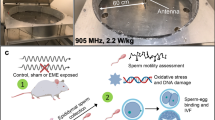Abstract
The exposure of male mice to radiofrequency radiations from mobile phone (GSM) base stations at a workplace complex and residential quarters caused 39.78 and 46.03%, respectively, in sperm head abnormalities compared to 2.13% in control group. Statistical analysis of sperm head abnormality score showed that there was a significant (p < 0.05) difference in occurrence of sperm head abnormalities in test animals. The major abnormalities observed were knobbed hook, pin-head and banana-shaped sperm head. The occurrence of the sperm head abnormalities was also found to be dose dependent. The implications of the observed increase occurrence of sperm head abnormalities on the reproductive health of humans living in close proximity to GSM base stations were discussed.


Similar content being viewed by others
References
Abdel-Rassoul G, Abou El-Fateh O, Abou Salem M, Michael A, Farahat F, Batanouny M, Salem E (2007) Neurobehavioral effects among inhabitants around mobile phone base stations. Neuro Toxicol 28:434–440
Aitken R, Bennetts L, Sawyer D, Wiklendt A, King B (2005) Impact of radiofrequency electromagnetic radiation on DNA integrity in the male germline. Int J Androl 28:171–179
Bakare AA, Mosuro AA, Osibanjo O (2005) An in vivo evaluation of induction of abnormal sperm morphology in mice by landfill leachates. Mutat Res 582:28–34
Beatty RA (1970) The genetics of the mammalian gamete. Biol Rev 45:2–119
Bortkiewicz A, Zmyslony M, Szyjkowska A, Gadzicka E (2004) Subjective symptoms reported by people living in the vicinity of cellular phone base stations. Rev Med Pr 55:345–351
Bruce WR, Heddle JA (1979) The mutagenic activity of 61 agents as determined by the micronucleus, Salmonella and sperm abnormality assays. Canada J Genetic Cytol 21:319–334
Dasenbrock C (2005) Animal carcinogenicity studies on radiofrequency fields related to mobile phones and base stations. Toxicol Appl Pharmacol 207(2):342–346
Diem E, Schwarz C, Adlkofer F, Jahn O, Rudiger H (2005) Non-thermal DNA breakage by mobile-phone radiation (1800 MHz) in human fibroblasts and in transformed GFSH-R17 rat granulose cells in vitro. Mutat Res 583:178–183
ICNIRP–International Commission on Non-Ionising Radiation Protection (1998) Guidelines for limiting exposure to time-varying magnetic and electromagnetic fields up to 300 GHz. Health Phys 74:494–522
Markov M, Kostarakis P (2007) Biological effects of electromagnetic fields. Environmentalist 27:385
Mashevich M, Folkman D, Kesar A, Barbul A, Korenstein R, Jerby E (2003) Exposure of human peripheral blood lymphocytes to electromagnetic fields associated with cellular phones leads to chromosomal instability. Bioelectromagnetics 24:82–90
Odeigah PGC (1997) Sperm-head abnormalities and dominant lethal effects of formaldehyde in albino rats. Mutat Res 389:141–148
Otubanjo OA, Mosuro AA (2001) An in vivo evaluation of induction of abnormal sperm morphology by some anthelminthic drugs in mice. Mutat Res 497:131–138
Pacini S, Ruggiero M, Sardi I, Aterini S, Gulisano F, Gulisano M (2002) Exposure to global system for mobile communication (GSM) cellular phone radiofrequency alters gene expression, proliferation and morphology of human skin fibroblasts. Oncol Res 13:19–24
Tice RR, Hook GG, Donner M, McRee DI, Guy AW (2002) Genotoxicity of radiofrequency signals. I. Investigation of DNA damage and micronuclei induction in cultured human blood cells. Bioelectromangnetics 23:113–126
Valberg PA, van Deventer E, Repacholi MH (2007) Workgroup report: base stations and wireless networks–radiofrequency (RF) exposures and health consequences. Environ Health Perspect 115(3):416–424
Wyrobek AJ, Gordon LA, Burkhart JG, Francis MW, Kapp Jnr RW, Letz G, Malling HG, Topham JC, Whorton M (1983) An evaluation of the mouse sperm morphology test and other sperm tests in non-human mammals. A report of United States EPA Gene-Tox program. Mutat Res 115:1–72
Acknowledgments
This research is sponsored by the University of Lagos Central Research Committee (CRC) grant No. 2007/18. Ethics: The experiments carried out involved the utilization of whole and live mice. However, aiming for the protection and welfare of animals, studies were conducted in accordance with the Nigerian and University of Lagos Ethics Committee guidelines for experiment with whole animals.
Author information
Authors and Affiliations
Corresponding author
Rights and permissions
About this article
Cite this article
Otitoloju, A.A., Obe, I.A., Adewale, O.A. et al. Preliminary Study on the Induction of Sperm Head Abnormalities in Mice, Mus musculus, Exposed to Radiofrequency Radiations from Global System for Mobile Communication Base Stations. Bull Environ Contam Toxicol 84, 51–54 (2010). https://doi.org/10.1007/s00128-009-9894-2
Received:
Accepted:
Published:
Issue Date:
DOI: https://doi.org/10.1007/s00128-009-9894-2




